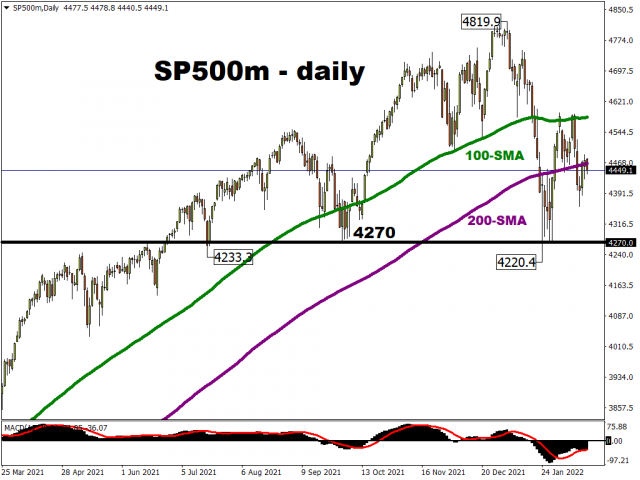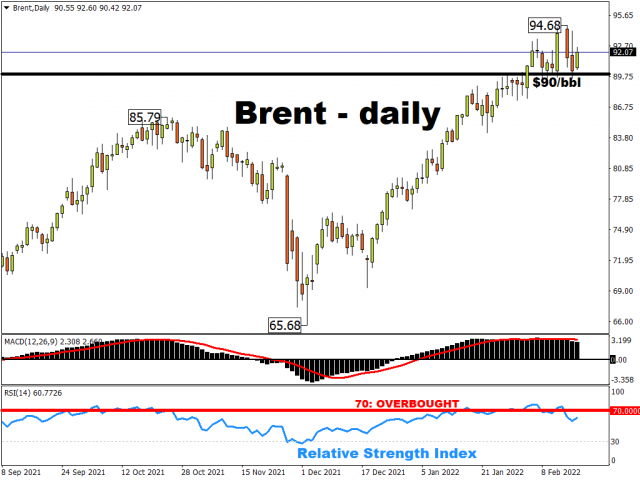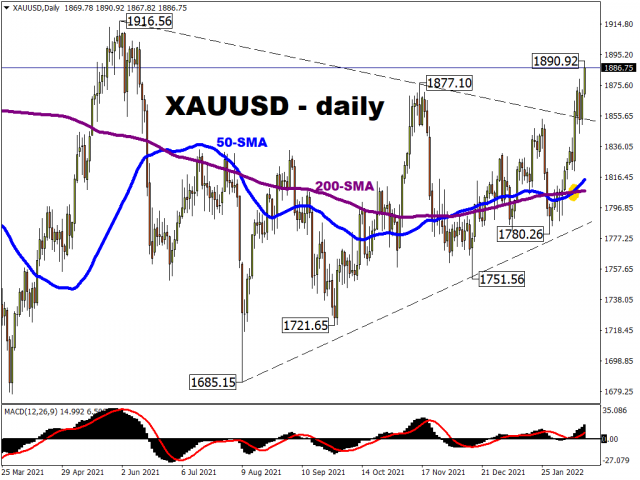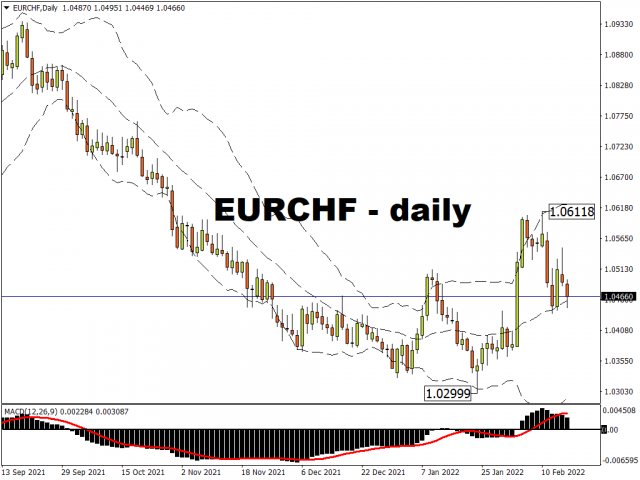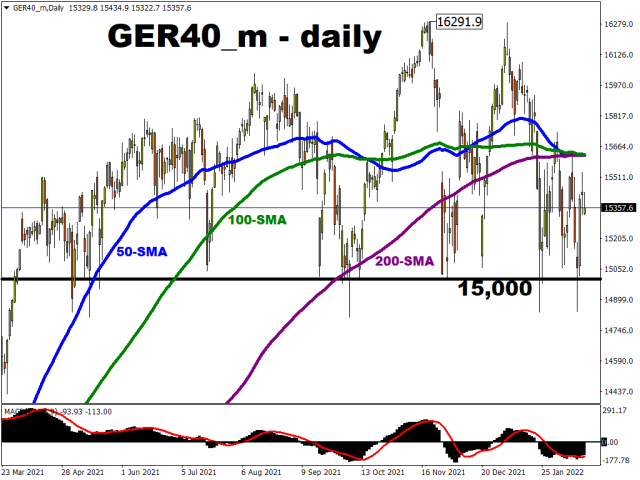Markets have been rocked by the latest twists and turns surrounding the Ukraine crisis.
Last weekend, the US warned that a Russian attack was imminent, only to be followed by reports that Russian forces are being pulled back from the border. At the time of writing, the latest headlines feature talk of a violation of cease-fire rules, and doubt being cast by the US and NATO as to whether Russian troops are indeed being withdrawn. The latest updates have prompted US stock futures to pull back, leaving the S&P 500 index cowering below its 200-day simple moving average for now.
All this speculation and uncertainty has left investors and traders on edge, leaving them wondering what could happen to various assets if this Ukraine crisis escalates?
Free Reports:
Download Our Metatrader 4 Indicators – Put Our Free MetaTrader 4 Custom Indicators on your charts when you join our Weekly Newsletter
Get our Weekly Commitment of Traders Reports - See where the biggest traders (Hedge Funds and Commercial Hedgers) are positioned in the futures markets on a weekly basis.
Here are a few potential scenarios:
1) Brent oil may top $100
At the start of the week, Brent oil, which is the benchmark used worldwide for oil prices, reached its highest levels since 2014. That climb was driven in part by the escalating tensions surrounding the Ukraine crisis, though Brent prices have since dropped slightly on signs that tensions are easing.
Note that half of Russia’s oil exports go to Europe. If an invasion on Ukraine forces Europe to impose sanctions on Russian oil and disrupt supplies, that could make oil harder to find in a world that needs it as economies continue their post-pandemic reopening.
Scarcer oil supplies should boost prices, potentially sending Brent to $100 for the first time since 2014.
2) Gold may reach $1900
Gold has had a fabulous February so far, boasting a month-to-date climb of almost 5%. Sure, a lot of that has been due to gold traditional role as an inflation hedge. However, the precious metal is also seen as a safe haven asset, meaning that investors lap gold up during times of heightened fear and uncertainty.
From a technical perspective, spot gold formed a ‘golden cross’ last week, which is where its 50-day moving average (blue line) crosses above its 200-day moving average (purple line). Such a technical event typically points to more gains, and indeed spot gold has already broken above the downward trend line that had capped gains since spot gold posted its all-time high back in August 2020.
Of course, an armed conflict involving major economies would send markets scurrying towards gold, potentially pushing up prices past that psychologically-important $1900 level last seen in June 2021.
3) EURCHF may fall past 1.03
The Swiss Franc (CHF) is also widely regarded as a safe haven asset, in contrast to the euro currency which could be dragged lower by any worsening in the Ukraine crisis, given that Europe gets a third of its gas supplies through Ukraine.
Hence, this contrast between Europe being negatively impacted by the Ukraine crisis, along with the Swiss Franc’s role as a safe haven, could send CHF towards its strongest levels against the euro since 2015.
Already back in 24th January 2022, amid swirling concerns of the Ukraine crisis, EURCHF had dipped below that psychologically-important 1.03 level, only to have recovered since.
Still, this currency pair remains sensitive to developments pertaining to the Ukraine crisis, and traders would have little qualms sending EURCHF to a new 7-year low if an armed conflict erupts.
4) DAX could break decisively below 15,000
The DAX is the benchmark index for Germany’s stock market (this index gives you an idea how Germany’s stock market is doing overall).
Already, the DAX is the worst-performing major stock index in Europe, dragged lower by fears surrounding the Ukraine crisis. So far this year, the DAX has fallen by 0.28% which is a bigger drop compared to France’s CAC (-0.21% year-to-date), and the Euro Stoxx 50 (-0.16% year-to-date). From a technical perspective, seeing as how the DAX’s 50-, 100-, and 200-day simple moving averages have converged, it appears that German stocks have been seized by fear, reluctant to move decisively one way or the other given the dark clouds that hang overhead.
Yet, those who have been tracking this benchmark index would’ve noticed that, since March 2021, the DAX has been able to claw its way back above 15,000 every time it drops below that psychologically-important level. In market lingo, we would say that the 15,000 level has offered strong “support” for the DAX.
However, the DAX’s 15,000 support may come undone if the Ukraine crisis takes a major turn for the worse.
5) Russian Ruble may weaken towards 80 versus US dollar
Since spiking past 80 against the US dollar in January, the Russian Ruble has pared back some of the losses amid the ongoing Ukraine crisis. USDRUB rises when the Ruble weakens, and USDRUB falls when the Ruble strengthens against the greenback.
Still, USDRUB remains supported above its 50-day simple moving average for support, amid lingering concerns.
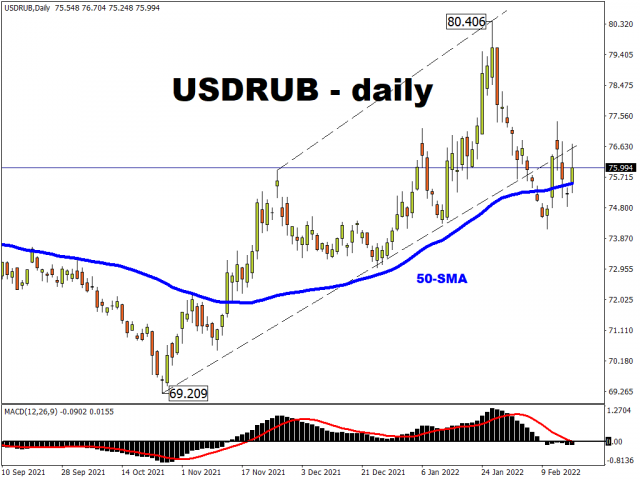
Overall, the threat of sanctions against Russia has to be greatly diminished in order for the Ruble to regain its strength as reflected by the nation’s strong economic fundamentals and the gains from oil prices. Note that, as of 2020, Russia is the third largest oil-producing nation in the world (after the US and Saudi Arabia). Hence, the Ruble has a strong relationship with oil prices: RUB typically strengthens alongside rising oil prices considering how important the commodity is to the Russian economy).
Otherwise, a further escalation in the Ukraine crisis which raises the prospects of sanctions against Russia could diminish demand for the Ruble, which may then revisit the psychologically-important 80 mark against the US dollar.
Overall, it appears there that the Ukraine crisis will not come to a conclusive end anytime soon, with EU and G7 leaders set to meet on the matter in the coming days.
In the meantime, market participants will have to keep watch and monitor how these various assets respond to the next stage of the ongoing Ukraine crisis.
Disclaimer: The content in this article comprises personal opinions and should not be construed as containing personal and/or other investment advice and/or an offer of and/or solicitation for any transactions in financial instruments and/or a guarantee and/or prediction of future performance. ForexTime (FXTM), its affiliates, agents, directors, officers or employees do not guarantee the accuracy, validity, timeliness or completeness, of any information or data made available and assume no liability as to any loss arising from any investment based on the same.
 Article by ForexTime
Article by ForexTime
ForexTime Ltd (FXTM) is an award winning international online forex broker regulated by CySEC 185/12 www.forextime.com

- It Looks Like Its a Good Time To Buy This Gold Stock Mar 28, 2025
- Copper Co. Should Be Up Way Higher Mar 28, 2025
- Banxico cut the rate by 0.5%. The global auto market is under pressure from the introduction of tariffs. Mar 28, 2025
- The Pound Stands Strong Amid Global Trade Tensions Mar 28, 2025
- Uncertainty over the scope and impact of tariffs increased market volatility Mar 27, 2025
- EUR/USD Faces Further Decline Amid Market Jitters and Trump’s Tariff Threat Mar 27, 2025
- Australia’s inflation rate is at a 3-month low. Oil prices are approaching $70 again Mar 26, 2025
- USD/JPY Rises Again: Yen Lacks Support as Bulls Take Control Mar 26, 2025
- Oil prices rise amid a new OPEC+ plan to cut production. Inflation in Singapore continues to weaken. Mar 24, 2025
- SNB cut the interest rate to 0.25%. Inflationary pressures are easing in Hong Kong and Malaysia Mar 21, 2025


